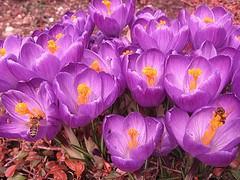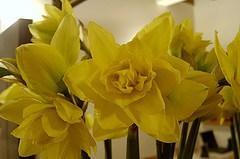When I wrote that title I imagined being able to link to a menagerie of spring planting posts and articles but alas getting your garden reading for Spring is always conventional… or at least it was!
Get Spring Planting Underway
Yes we may be heading towards October which is in fact five months until we get to Spring (sorry that’s rather depressing but bear with me), but this is exactly the right time to be thinking about it.
Forget detailed plans and beautifully created design plots with green areas for shrubs and and pink areas for flowers.
Today I’m going to discuss how to get your garden ready for Spring and not only that it will be simple, easy and absolutely beautiful. Not only that but it will wish you through the cold weather (bar the Christmas break) quicker than you can say Aladdin.
Planting Guide
- Decide on the area you want your spring garden to come alive. Don’t be restricted by space though. Think in terms of pots you have (already), lawn edges, flower beds and of course cultivation areas. Do you want the spring area to come up in patches, lines or create a new area completely?
If you can’t decide at this point in time then don’t panic. Move on to step two.
- Buy the biggest bag (or bags) of flowering bulbs you can afford. Best places to get bulbs are either online or local pound stretcher, or local garden centre. Don’t buy them from DIY shops, they are extortionate in price and you don’t get much for your buck.
Now I know a lot of people like to think in colour with their garden as they would the rooms in their homes. So you could also buy in groups of colours. Black tulips with white daffodils for example.
The important thing with bulbs is to make IMPACT. You don’t want to be planting the odd bulb here and about the garden. Not only will you be looking at that lonely bulb and feel sorry for it come March/April but it will take years to divide and multiply.
So that’s why you need to buy as many bulbs as possible.
The other thing you need to think of when buying bulbs is to make the flowering period as long as possible but not too long that you’ll never be able to plant anything else.
Flowering months for the most common (and easiest to grow), go something like this:
- February – Snowdrops
- March – Daffodils
- April/May – Tulips and Muscari
- May – Bluebells
All the above need to be planted between now and end of Dec at the latest.
When picking the bulbs remember that your choice could be the very savior to all the nectar loving insects coming out of hibernation after winter, so be sure to look for “Bee friendly” or “wildlife friendly” labelled bags.
If in doubt as to whether a type of bulb is insect friendly or not make sure the pollen can be accessed easily. The flowering heads will be open rather than closed. For example:


So now you’ve picked your bulbs you need to decide where they are to be planted.
Here’s a tip – in February and March which are probably the most dull and lifeless in the garden any flowering bulbs at this stage will be a real focus to the eye so be sure to plant any bulbs where you’ll be able to see the flowers from the house.
- Get a spade or a trowel, your bulbs and head outside.
- Dig a hole (twice the depth of the bulbs) and evenly place as many bulbs as you can in the space without the bulbs touching each other. Cover the bulbs and leave.
- Do this all over you garden. Dig a hole, plant, cover. In the lawn, in the veg beds, in patio containers. Dig, plant, cover.
Done.
If you know of bulbs that come up already in your garden then you could add to those collections. Or start new ones.
Don’t think formal. Formal is just boring and lets be honest the bees and other nectar loving insects don’t care if it’s a line of tulips or a multitude of daffodils, snowdrops and crocus all in one spot.
Here’s another tip: I fill any pots and containers that contain perennials with any odd, left over bulbs. That way I use up all the bulbs and they won’t look out of place by something already growing in place.
It’s just about the easiest form of flower planting there is and when winter really hits you’ll be chuffed sat inside all nice and warm knowing that not only are the blooms going to look wonderful (and it’s fun to see what pops up where if like me you forget), but you’ve just saved the lives of some rather important insects that will be very grateful for that extra helping hand in the food dept.
Just one final thought. If you think you haven’t got space to make an impact in your garden space then think again. One medium sized pot can hold up to 10 bulbs. Not only is that enough to make a colorful addition to your patio/balcony/windowsill but it won’t be overlooked by the bees.
So are you ready to hit your garden with the trowel?
Let me know what you’re favourite bulbs are and where’s the most unusual place you’ve planted them
____________________________________
Daffodil courtesy of Jason Weaver
Crocus courtesy of Mcmamauri
Cover photo courtesy of Dawn Perry
